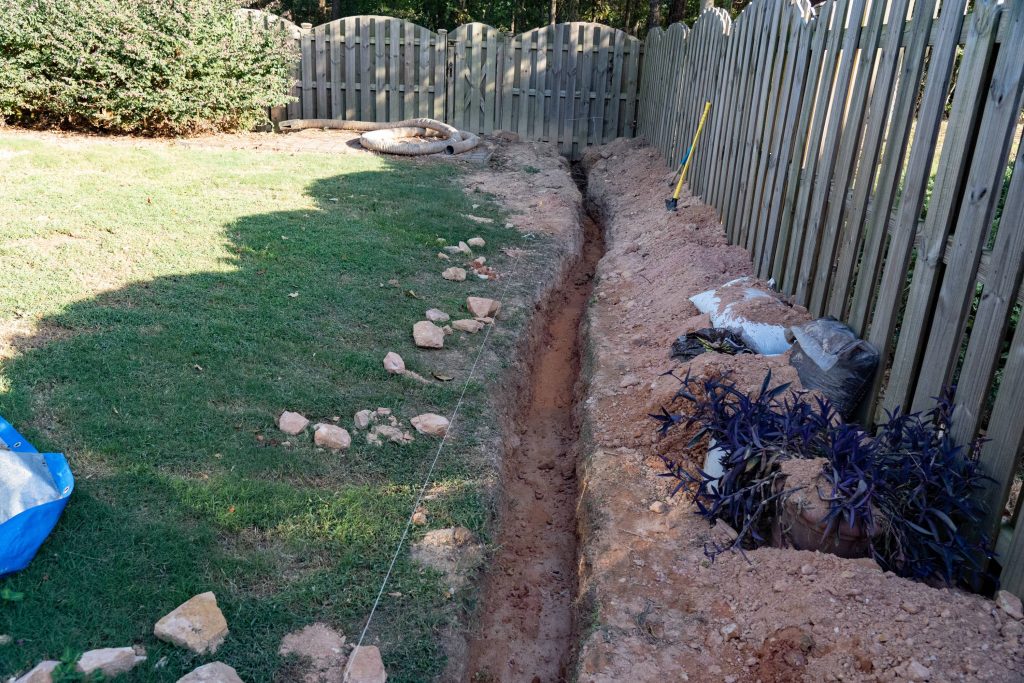
If you thought home drainage solutions and style weren’t synonymous, let us introduce you to the French drain.
While there are several options for homeowners looking to channel water away from parts of their property, few are as simple yet elegant as the French drain.
French drain installation is a type of drainage solution that effectively reduces puddles and leaks and is aesthetically pleasing.
If you’re looking for a landscaping and drainage solution for your marshy lawn or leaky basement, continue reading to learn more about French drain installation and if you should install one on your property.
What Is a French Drain?
A French drain is a method of rerouting water from your property with an aesthetically pleasing trench. Typically, French drains are covered in small pebbles or stones to create a landscape design element that enhances the look of your home.
First, a trench gets dug at a slope of around one inch deep for every eight feet long. Then, gravel gets placed into the trench and lined with landscape fabric or geotextiles. This water-permeable fabric allows water to drain down but discourages weed growth.
Next, the trench gets fitted with a drainage pipe with holes at the top to allow water to flow in. Finally, the pipe gets covered with pebbles or stones and becomes a French drain.
While catch basins are the most familiar type of drainage solution, French drains are a popular solution for those who want to add various textures to their outdoor spaces. It is possible to cover a French drain with grass instead of stones; however, adding grass makes future maintenance work more of an effort.
How a French Drain Protects Your Home
French drain installation is an excellent way to protect your home from water damage. If your home experiences flooding, water leaks near the foundation, or marshy areas on the lawn, a French drain might be the solution to protect your home and outdoor spaces.
When a property slopes, it can lead water to your home’s foundation instead of getting channeled to a safer location. During heavy rainstorms, excess water pooling at the foundation can leak into your house, causing major damage to your basement.
French drain installation near your home’s foundation can help reroute puddles away from the foundation to a better place like your garden, municipal storm drains, or a catch basin to harvest rainwater.
Suppose puddles on your lawn or garden are drowning your plants. In that case, a French drain can help reduce flooded areas and spread the water to drier parts of your property or areas with better drainage.
Who Should Have a French Drain?
Installing a French drain is a smart solution for anyone who owns a property with slopes that cause water to pool in unwanted areas. If your basement leaks or floods every time it rains, a French drain can help eliminate future leaks.
A French drain adds texture to properties with a line of stones that contrasts against a green lawn appealingly. Installing a French drain is an excellent choice if you want to add some hardscaping and eliminate pooled water on your property.
Who Shouldn’t Have a French Drain?
Not all landscapes accommodate French drain installation. You shouldn’t get a French drain unless you plan to change your yard and landscape grading drastically if you have any of the following:
- A property that doesn’t have an adequate slope for rerouting water
- A property that slopes into a neighbor’s property
- A property that’s near protected land
It’s essential to consider where water from your French drain will drain out to. You shouldn’t drain your water onto your neighbor’s property, nor should you disturb a protected ecosystem near your land.
In some cases, homeowners need a permit from their municipality before installing a French drain. Those unwilling to obtain a permit in areas that require them shouldn’t install a French drain.
Where To Install a French Drain?
The two most common areas for French drain installation are near the foundation of the house or around the perimeter of the property. We’ll discuss both below.
Foundation
Suppose the land slopes towards your home. It can cause water to pool near your foundation and damage the structure or leak into your basement. In that case, a French drain placed near your foundation can help collect the puddles and channel them to a more suitable area on your property or to your city drainage system.
Outer Perimeter
If the land slopes away from your home but water pools on parts of your lawn or in your garden beds, a French drain along the outer perimeter of your property can reroute the water elsewhere.
How Long Do French Drains Last?
One of the best things about French drain installation is its long lifespan. A French drain typically lasts up to 40 years before it needs replacing.
That said, annual maintenance is the best way to keep your French drainage system in tip-top shape for many decades. Over the course of a year, dirt and sediment can build up in the pipes of your drain system, so cleaning it of debris once a year helps ensure it does the job effectively.
It’s also essential to clear away any weeds growing over your French drain. Remember, avoid using harmful pesticides on weeds or overgrowth since pesticides can contaminate groundwater.
Protect Your Home with French Drain Installation
Protect your home from leaks and waterlog with professional French drain installation from Architectural Landscape Design. Our team of professionals will help you grade the slopes of your property or install the perfect drainage solutions to create ideal conditions for your plants to flourish and your home to stay dry.
Contact us today to discuss how we can help you protect your home from water damage with French drain installation. Our expert drainage contractors will do an evaluation of your property and find the right option for every homeowner in Minneapolis and the Twin Cities.
